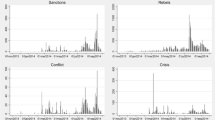Abstract
We study stock market reactions to large international military conflicts since World War II. Using a news analysis proxy for the estimated likelihood that a conflict will result in a war, we find that an increase in the war likelihood tends to decrease stock prices, but the ultimate outbreak of a war increases them. In cases when a war starts surprisingly, however, the outbreak of a war decreases stock prices. We show that this puzzle cannot be explained by risk or ambiguity aversion or by expectations about a quick end of the war.








Similar content being viewed by others
Notes
Standard predictive models are often constructed such that changes in variables at time \(t + 1\) are explained by changes in variables at time t. In our case, this approach would require to use a variable for the war likelihood which realizes prior to actual changes in the stock market. However, since our argument is to use the news proxy as a flexible probability measurement which is available for different wars over time, the functional forms used here slightly differ from standard models due to the delay of news publication. This, however, does not alter the models’ predictive power.
Also, the error correction parameter γ is significantly negative as expected for both types of probability measurements.
That is, the data set ranges from \(\tilde{t} - 25\) to \(\tilde{t} + 25\) days around \(\tilde{t}\).
We use this type of structural break analysis since we are interested in whether there exists an instantaneous jump in the stock market index at the onset of a war. An alternative question would be whether there are possible changes in the trend of the stock market. For that purpose, a model testing for changes in expected growth rates of stock returns may be appropriate (see Amihud and Wohl 2004).
Note that the estimated structural break on March 18 coincides with the beginning of the US ultimatum to Saddam Hussein. Investors might have anticipated that this ultimatum would not be agreed upon which caused an early rise in stock market values.
CRS Report for Congress, Costs of Major U.S. Wars, July 2008.
The Gulf War is often also referred to as Second Gulf War or Persian Gulf War.
Although it would be interesting to see how stock markets evolved in the countries were war actually took place, this analysis is often not feasible. Either stock exchanges were not yet institutionalized or controlled by the government so that data would not be reliable, or data are not available.
Due to issues of data availability, we could not perform a similar analysis for global wars having occurred earlier in history.
Li and Sacko (2002) find that an unexpected onset of a military dispute reduces bilateral trades more severely.
This holds true unless we studied intra-day data which in most of these cases is not available.
For simplicity, we normalize the investor’s return for a “peace portfolio” to one in the case of a peaceful resolution.
References
Amihud Y, Wohl A (2004) Political news and stock prices: the case of Saddam Hussein contracts. J Bank Financ 28(5):1185–1200
Chappell D, Eldridge R (2000) Evidence of market inefficiency in a war environment. Appl Financ Econ 10(5):489–492
Collier P, Hoeffler A (1998) On economic causes of civil war. Oxford Econ Pap 50(4):563–573
Cutler D, Poterba J, Summers L (1989) What moves stock prices? J Portf Manag 15(3):4–11
Elmendorf D, Hirschfeld M, Weil D (1996) The effect of news on bond prices: evidence from the United Kingdom, 1900–1920. Rev Econ Stat 78(2):341–344
Frey B, Kucher M (2000) History as reflected in capital markets: the case of World War II. J Econ Hist 60(2):468–496
Goldstein J (1992) A conflict-cooperation scale for WEIS events data. J Conflict Resolut 36(2):369–385
Guidolin M, La Ferrara E (2010) The economic effects of violent conflict: evidence from asset market reactions. J Peace Res 47(6):671–684
Holsti O, North R (1966) Comparative data from content analysis: perceptions of hostility and economic variables in the 1914 crisis in comparing nations. In: Merritt R, Rokkan S (eds) The use of quantitative data in cross-national research. Yale University Press, New Haven, pp 169–199
Keynes J (1919) The economic consequences of the peace, reprint 1971 edn. Macmillan, London
Li Q, Sacko D (2002) The (ir)relevance of militarized interstate disputes for international trade. Int Stud Q 46(1):11–43
Niederhoffer V (1971) The analysis of world events and stock prices. J Bus 44(2):193–219
Powell R (2002) Bargaining theory and international conflict. Annu Rev Polit Sci 5(1):1–30
Rigobon R, Sack B (2005) The effects of war risk on US financial markets. J Bank Financ 29(7):1769–1789
Russett B, Hanson E (1975) Interest and Ideology: the foreign policy beliefs of American businessmen. Freeman, San Francisco
Schelling T (1966) Arms and influence. Yale University Press, New Haven
Schneider G, Troeger V (2006) War and the world economy: stock market reactions to international conflicts. J Conflict Resolut 50(5):623–645
Wolfers J, Zitzewitz E (2009) Using markets to inform policy: the case of the Iraq War. Economica 76(302):225–250
Acknowledgments
We thank our students Marco Lang, Laura Leoni, Raphael Müller, and Thomas Rast for their help with the data collection and analysis as well as Florian Herzog from swissQuant, Yakov Amihud, and Christian Ehm as well as anonymous referees for useful comments. Support by the National Centre of Competence in Research “Financial Valuation and Risk Management” (NCCR FINRISK), Project A1, “Behavioural and Evolutionary Finance,” and by the University Priority Program “Finance and Financial Markets” of the University of Zurich is gratefully acknowledged.
Author information
Authors and Affiliations
Corresponding author
Rights and permissions
About this article
Cite this article
Brune, A., Hens, T., Rieger, M.O. et al. The war puzzle: contradictory effects of international conflicts on stock markets. Int Rev Econ 62, 1–21 (2015). https://doi.org/10.1007/s12232-014-0215-7
Received:
Accepted:
Published:
Issue Date:
DOI: https://doi.org/10.1007/s12232-014-0215-7




